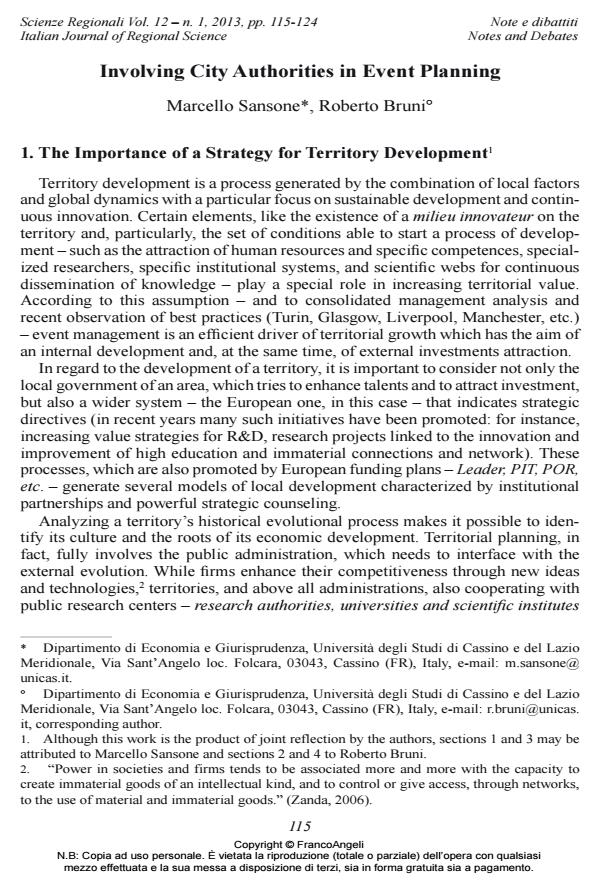Involving City Authorities in Event Planning
Titolo Rivista SCIENZE REGIONALI
Autori/Curatori Marcello Sansone, Roberto Bruni
Anno di pubblicazione 2013 Fascicolo 2013/1 Lingua Inglese
Numero pagine 9 P. 115-123 Dimensione file 188 KB
DOI 10.3280/SCRE2013-001006
Il DOI è il codice a barre della proprietà intellettuale: per saperne di più
clicca qui
Qui sotto puoi vedere in anteprima la prima pagina di questo articolo.
Se questo articolo ti interessa, lo puoi acquistare (e scaricare in formato pdf) seguendo le facili indicazioni per acquistare il download credit. Acquista Download Credits per scaricare questo Articolo in formato PDF

FrancoAngeli è membro della Publishers International Linking Association, Inc (PILA)associazione indipendente e non profit per facilitare (attraverso i servizi tecnologici implementati da CrossRef.org) l’accesso degli studiosi ai contenuti digitali nelle pubblicazioni professionali e scientifiche
- Hussar W. J. (1999), Predicting the Need for Newly Hired Teachers in the United States to 2008-09. Washington DC: National Center for Education Statistics.
- Hsiao C. T., Peng H. L., Chien-Yuh Lee B. (2009), A Dynamic Demand-Supply Model For Elementary School Teachers in Taiwan. International Journal of Electronic Business Management, 7, 3: 190-200.
- Inman R. P. (1978), Optimal Fiscal Reform of Metropolitan Schools: Some Simulation Results. The American Economic Review, 68, 1: 107-122.
- McNamara J. F. (1971), Mathematical Programming Models in Educational Planning. Review of Educational Research, 41, 5: 419-446 DOI: 10.3102/00346543041005419
- MEF – Ministero dell'Economia e Finanze, MIUR – Ministero dell'Istruzione, Università e Ricerca (2007), Quaderno Bianco sulla Scuola, Roma.
- OECD (2005), Teachers Matter: Attracting, Developing And Retaining Effective Teachers. Paris: Oecd.
- Ragioneria Generale dello Stato (2011), Un modello per la simulazione di medio-lungo termine del fabbisogno scolastico – Simulazioni 2010-2027 e impatti differenziali delle riforme in corso. Roma (www.rgs.mef.gov.it).
- Ragioneria Generale dello Stato (2009), Il Rapporto sulla spesa delle Amministrazioni centrali dello Stato – anno 2009. Roma (www.rgs.mef.gov.it).
- Saltenis V., Dzemyda G., Tiesis V. (2002), Quantitative Forecasting and Assessment Models in the State Education System. Informatica, 13, 4: 485-500.
- Santiago P. (2002), Teacher demand and supply: Improving Teaching Quality and Addressing Teacher Shortages. Paris: Oecd, Education Working Papers n. 1.
- Webster T. (2004), Cost Analysis and its Use in Simulation of Policy Options: The Papua New Guinea Education Finance Model. International Review of Education, 43, 1: 5-23. DOI: 10.1023/A:1002976716332
- Gursoy D., Kim K., Uysal M. (2004), Perceived Impacts of Festivals and Special Events by Organizers: an Extension and Validation. Tourism Management, 25, 2: 171-181. DOI: 10.1016/S0261-5177(03)00092-X
- Hall C. M. (1989), The Definition and Analysis of Hallmark Events. Geojournal, 19, 3: 263-268. DOI: 10.1007/BF00454570
- Hiller H. (2000), Mega Events, Urban Boosterinsm and Growth Strategies: An Analysis of the Objectives and Legitimations of the Cape Town 2004 Olympic Bid. International Journal of Urban and Regional Research, 24, 2: 449-458. DOI: 10.1111/1468-2427.00256
- Holbrook M. B., Hirschman E. C. (1982), The Experiential Aspects of Consumption: Consumer Fantasies, Feelings, and Fun. Journal of Consumer Research, 9, September: 132-140. DOI: 10.1086/208906
- IOC - International Olympic Committee (1998), Olympic Marketing, 1998 Fact File. Lausanne: IOC.
- Kaplau R. S., Norton D. P. (2000), Having Trouble with Your Strategy? Then Map It. Harvard Business Review,78, 5: 167-176.
- Pine B. J., Gilmore J. H. (1999), The Experience Economy: Work is Theatre & Every Business a Stage. Cambridge: Harvard Business School Press
- Prahalad C. K., Ramaswamy V. (2004), Co-creating Unique Value with Customers, Strategy & Leadership, 32, 3: 4-9. DOI: 10.1108/10878570410699249
- Ritchie J., Smith B. (1991),The Impact of a Mega-event on Host Region Awareness: a Longitudinal Study. Journal of Travel Research, 13, 2, 14-20. DOI: 10.1177/004728757401300202
- Roche M. (2000), Mega Events and Modernity. London: Routledge.
- Schmitt B. H. (1999), Experiential Marketing. New York: Free Press.
- Smith S., Wheeler J. (2002), Managing the Customer Experience. London: Prentice Hall.
- Shone A., Parry B. (2004), Successful Event Management. London: Thomson Ed.
- Visconti F. (2002), Il governo dei distretti industriali. Strategie, strutture e ruoli. Milano: Egea.
- Waitt G. (2003), Social Impacts of the Sydney Olympics. Annals of Tourism Research, 30, 1: 194-215. DOI: 10.1016/S0160-7383(02)00050-6
- Wood E. (2004), Marketing Information for the Events Industry. In: Yeoman I., Robertson M., All-Knight J., Drummond S., McMahon-Beattie U. (eds.), Festival and Events Management. An International Arts and Culture perspective. Amsterdam: Elsevier. 130-158.
- Zanda G. (2006), Lineamenti di economia aziendale. Roma. Kappa.
Marcello Sansone, Roberto Bruni, Involving City Authorities in Event Planning in "SCIENZE REGIONALI " 1/2013, pp 115-123, DOI: 10.3280/SCRE2013-001006